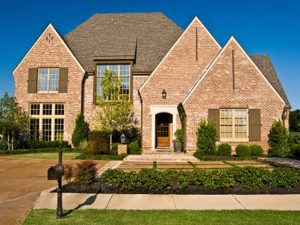The Benefits of a Sustainable Building

“Green buildings, like those that are LEED-certified, are a global solution for cities, communities, and neighborhoods. The tangible benefits may not be easily recognizable to tenants or visitors, but through sustainable design, construction and operations green buildings are reducing carbon emissions, energy and waste; conserving water; prioritizing safer materials; and lowering our exposure to toxins,” according to The U.S. Green Building Council (USGBC).
One of these materials is brick which is one of the world’s most sustainable building products. Ever since the beginning of time, homes, temples, water canals, streets and bridges were constructed of natural, maintenance-free construction material. These materials kept the ancient civilizations’ buildings warm in the winter and cool in the summer. Modern-day architects, builders, and homeowners choose brick for these main reasons.
“Clay brick has superior ‘Life Cycle Assessment,’” Mikaela Insall, who is a certified Leadership in Energy and Environmental Design (LEED) Green Associate and sales engineer for Acme Brick said. “This construction industry metric is an evaluation of the economic performance of a building over its entire life. Using clay brick versus other sidings such as wood or synthetic products will reduce the need for replacement and reduce the use of new materials for reconstruction.
“A clay brick veneer has superior impact resistance and has shown to withstand the impact of a 2×4 board, flying at 72 mph. When you choose clay brick, such as those manufactured by Acme Brick, for your home, you know it will be safe when a high windstorm blows through your neighborhood!”
Energy generated from the sun and wind is also becoming more mainstream. Natural brick can enhance energy savings from these natural sources.
“Insulating properties of buildings is very simplistically described by R-value,” Insall notes. “The built environment is subject to more complicated conditions. R-value is defined as the resistance to heat flow in ‘steady state’ conditions and climates are not so steady.
“It’s more important to consider cladding materials that have superior thermal mass benefits. Thermal mass is the material’s capacity to absorb and store heat. Dense materials such as clay brick and concrete have superior thermal mass capabilities.
“If you live in the Southwest and it’s August, you will probably have your AC running, non-stop. During the day, a clay brick wall will slowly heat up, but the temperature on the interior side of the brick wall will never reach the hottest temperature of the day. This is known as the ‘dampening effect’ because it heats up so slowly. When this occurs, a ‘thermal lag’ happens to the structure. The dampening effect and thermal lag are the two components that make up thermal mass.
“Other building materials may be better in ‘steady state’ conditions, but no building material has the superior thermal mass that a clay brick has. This thermal dampening can mean that less powerful air-conditioning (e.g. 2-ton versus 3-ton unit) is needed, saving the homeowner money.”
Brick not only saves along with energy resources but will help eliminate pollutants. One of these is VOCs (volatile organic compounds) which come from painting interior walls. Since brick is made from natural materials, it has no VOCs. Brick can also block noise pollution such as musical instruments, a stereo, or outside noise.
“Brick homes should last forever, but if reconstruction or additions to a home were to be done and some brick were removed in the process, those brick pieces can simply be used for your landscaping or garden. The brick pieces are an excellent source of minerals for the soil.”
“Recycling the brick of an existing structure means less material is needed for reconstruction or renovation. This is also an excellent eco-benefit. It means less money is needed for new material as well as less material that needs to be manufactured and shipped to a job site for reconstruction. This is not only good for your wallet but reduces greenhouse gas emissions too.”
Remember brick is a perfect material that will make your home or commercial building more sustainable and offer a better return on investment. Both brick and brick veneer are both perfect building materials for an eco-friendly project.
